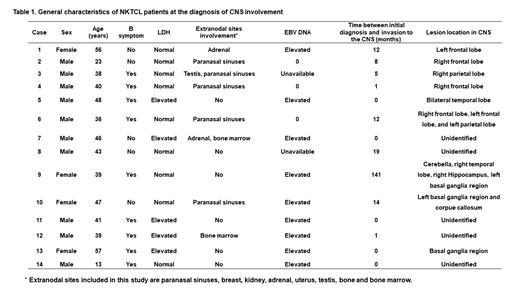Abstract

Introduction:Extranodal NK/T-cell lymphoma, nasal type (NKTCL) is an aggressive subtype of non-Hodgkin lymphoma that is characterized by extranodal presentation. Central nervous system (CNS) involvement in NKTCL is very rare and carries dismal outcome, but lacks clear consensus on optimal treatment. This study summarized the clinicopathological features, treatment patterns and survival outcomes of NKTCL patients with CNS involvement, in order to improve the understanding of CNS involvement in NKTCL.
Methods: 1019 patients diagnosed with extranodal NKTCL, from August 2010 to January 2021 were reviewed, and patients with CNS involvement were included in the analysis. The CNS involvement was diagnosed either pathologically or clinically. Due to the difficulties and potential hazards of brain biopsy, pathologic confirmation of CNS involvement was conducted by identifying malignant cells in the cerebrospinal fluid (CSF) by cytology and flow cytometry analysis. Clinically diagnosed CNS involvement was based upon the characteristic radiographic findings by magnetic resonance imaging (MRI), computed tomography (CT) or positron emission tomography (PET/CT), Circulating EBV-DNA was detected by quantitative polymerase chain reaction (PCR). Overall survival (OS) was defined as time from confirmation of CNS disease to death from any cause or last follow up.
Results: Among 1019 patients diagnosed with NKTCL, 14 cases (1.3%) with CNS involvement were included. The general characteristics of these patients are listed in Table 1. Of these 14 patients, the median age was 40.5 years (range, 14-57 years) at the time of diagnosis of CNS involvement. Approximately 71.4%(10/14)of patients were men. The median time between initial diagnosis of NKTCL and diagnosis of CNS involvement was 3.0 months (range, 0-141.0 months). 5 patients suffered CNS involvement at initial diagnosis of NKTCL. The other 9 CNS involvement were identified as disease progression. All patients underwent radiological examination, which disclosed the lesion location in CNS of 9 patient. The other 5 patients were diagnosed with CNS involvement by the examination of CSF. The elevated protein concentration and leukocytosis in CSF were identified in 8 and 2 patients, respectively. Among these patients with CNS involvement, the median number of treatment lines after the diagnosis of CNS involvement was 1.5 (range, 1-4). The best response was complete response (CR) in 11 patients, partial response (PR) in 1 patient, stable disease in 1 patient and progressive disease in 1 patient. CR was achieved when patients were treated with pegaspargase- containing regimens(n=4), anti-PD-1 antibodies-containing regimens(n=3), chidamide-containing regimens(n=2) and HD-MTX-containing regimens(n=2). After achieving CR, 2 patients received anti-PD-1 antibodies as maintenance treatment, with the duration of response of 26 and 72 months, respectively. With the median follow-up of 24.5 months (range, 4-72 months), 5 patients died of NKTCL, and the median OS was not reached. 9 patients presented with high circulating EBV-DNA level at diagnosis of CNS involvement, and the post-treatment EBV-DNA descended to the normal level in 7 patients, among whom 6 patients achieved CR.
Conclusions: The incidence of CNS involvement in NKTCL is low. Compared with previous studies, more patients received anti-PD-1 antibodies- and chidamide-containing regimens, which may contribute to the improved response rate and survival outcomes. Measurement of dynamic changes in EBV-DNA levels during the treatment process can be applied to monitor the treatment response.
No relevant conflicts of interest to declare.
Author notes
 This icon denotes a clinically relevant abstract
This icon denotes a clinically relevant abstract


This feature is available to Subscribers Only
Sign In or Create an Account Close Modal